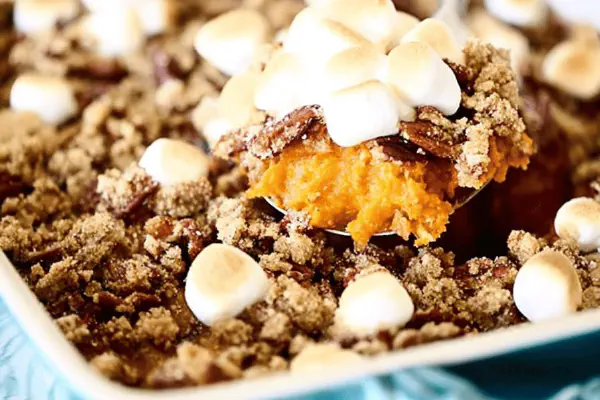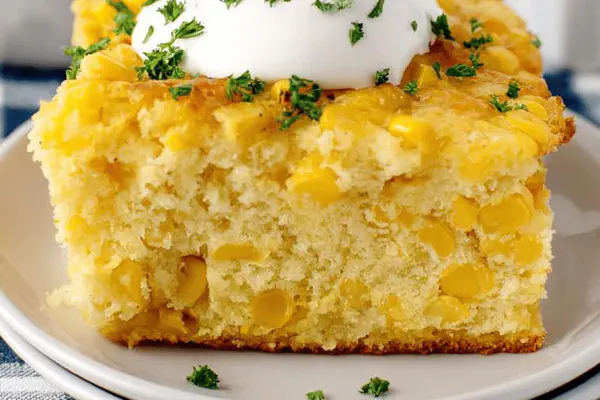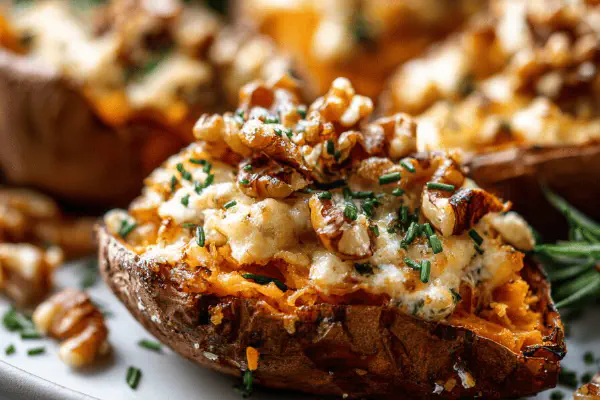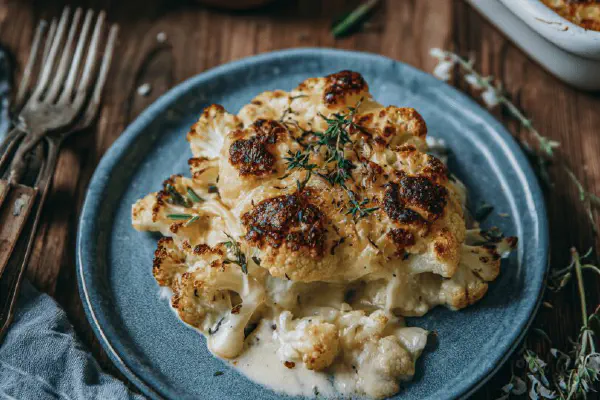Twisted Sweet Potato Bake

By Emma
Certified Culinary Professional
Ingredients
- 5 large sweet potatoes, washed and pricked
- 1 cup granulated sugar
- 1 tablespoon vanilla extract
- 2 large eggs
- 1 cup evaporated milk or substitute coconut milk
- 6 tablespoons browned butter, melted
- 3/4 cup brown sugar
- 1/3 cup all-purpose flour
- 6 tablespoons softened unsalted butter
- 1 cup chopped pecans
- 1 cup crushed pineapple, drained
- 2 cups mini marshmallows, divided
- Nonstick cooking spray
About the ingredients
Method
- Heat oven to 355°F. Line baking sheet with foil. Place washed, pricked sweet potatoes on foil. Roast 55-65 minutes. Done when knife pierces smoothly with no resistance, skin wrinkles slightly. Cool till handheld. Peel off skins, best with a paring knife or rub with paper towel to save time.
- Spray 2-quart casserole dish liberally with cooking spray. Avoid oil slicks, extra spray helps release sticky mashed mix later.
- Mash peeled potatoes in large bowl with masher or mixer. Rough chunks OK — gives texture. Stir in sugar, vanilla, eggs, evaporated milk (or coconut for tropical depth). Fold in browned butter, pour in crushed pineapple gently to avoid overmixing.
- For topping: fork together brown sugar, flour, and softened butter till crumbly like damp sand. Fold in pecans evenly distributed. No overmixing here—keep crumbs intact.
- Spread half mini marshmallows evenly atop sweet potato mix. Spoon crumb topping over marshmallows in a layer that hides them but shows texture.
- Bake 28 to 32 minutes. Watch edges bubbling and topping turning golden. Peek inside if unsure—topping should be set but not burned. Pull out carefully.
- Scatter remaining marshmallows on top. Bake additional 8 to 12 minutes until marshmallows puff, melt, and turn a light toasty brown. Listen for faint crackling as marshmallows toast. Watch constantly to prevent orange scorch marks.
- Rest at least 10 minutes before serving. Cool slightly to let flavors meld. Topping hardens a bit but stays gooey beneath. Slice with serrated knife for clean edges.
Cooking tips
Chef's notes
- 💡 Roast sweet potatoes whole, prick skin so steam vents. Oven smells shift from raw starch to earthy sweetness when done; poke easily with knife no resistance. Let cool enough to handle but warm helps peeling if careful. Avoid boiling or microwaving to skip waterlogging texture. Chunky mash needed—over-beat makes gluey paste, not rustic. Incorporate browned butter by melting slowly till nutty aromas pop but watch closely to not burn; pulls out flavor not from plain melted butter.
- 💡 Topping texture is key—fork together brown sugar, flour, softened butter 'til crumbly like wet sand not greasy. Fold in pecans careful—too much stirring crushes crumbs and ruins contrast. Marshmallows sprinkled two times; half under topping for sticky base, rest on top for melting and toasty browning cues. Watch edges and listen for faint crackling sounds as marshmallows brown—orange scorch warns too hot, pull early.
- 💡 Substitute evaporated milk with full-fat coconut milk for non-dairy tropical twist—adds richness, balances pineapple moisture. Drain crushed pineapple well or rinse syrup from canned fruit; wet mash leads to soggy, long bake times. Use foil-lined baking sheet for ease cleanup; cooking spray inside casserole dish stops stickiness and helps release later—extra spray better than risk burnt or stuck layer.
- 💡 Temperature guides doneness but aromas and visuals matter more here. Sweet potato skins wrinkle slightly, smell deep roasted and slightly caramelized. Topping’s done when edges bubble and golden, inside set but not dry. Slice warm after rest so topping hardens a little but inside gooey. Serrated knife cuts clean corners and marshmallow strings lessened. Pull gently to avoid wrecking layers.
- 💡 Watch marshmallow toast last minutes religiously. Puff, melt, then turn from pale to light golden brown. Crackling sound subtle but distinct under quiet kitchen. Over-bake and marshmallows scorch orange, taste bitter. If unsure, peek inside and check topping firmness. Rest after baking lets sugars and moisture meld—topping forms contrast to creamy middle. Double marshmallow layers prevent soggy crust and add dimension. Keep texture layers distinct—important for mouthfeel.
Common questions
Can I use canned sweet potatoes?
Canned mash lacks texture and dryness needed. You’d lose roasted depth. Not recommended but if pressed, drain thoroughly and adjust butter/sugar down to avoid wet mix. No roasting aroma either.
What if I don’t have pecans?
Toasted walnuts or almonds sub okay but pecans unique buttery crunch. Use less nuts if swapping or topping clumps too much. Toast nuts dry in skillet first to wake flavor. Unsalted only to control salt balance.
How to avoid soggy topping?
Drain pineapple well—water is enemy. Use plenty of butter in crumb top, fork gently not stirring obsessively. Marshmallows twice in layers add texture and shield mash from moisture. Foil liner helps with excess syrup or burnt residues avoidance too.
Can leftovers be frozen?
Freeze in airtight container after cooling. Best reheated covered in oven or microwave to soften marshmallow crust gently. Thaw in fridge overnight first. Avoid refreeze once thawed to preserve texture and taste. Real talk: fresh is better but freezing works if needed.



